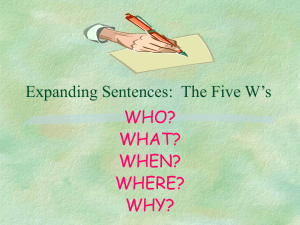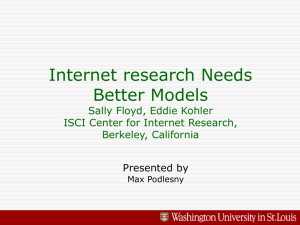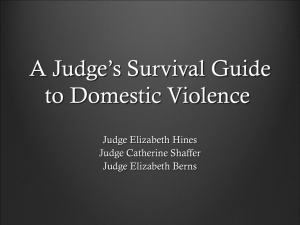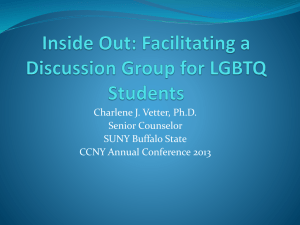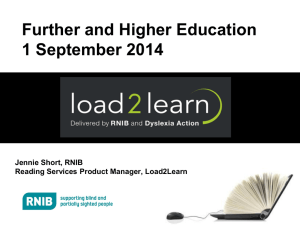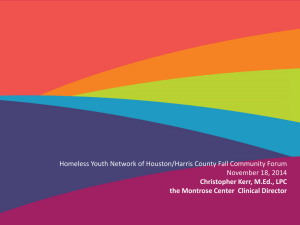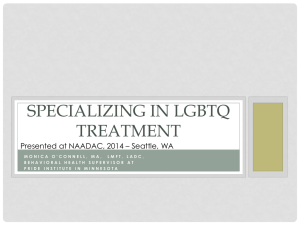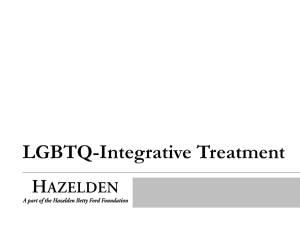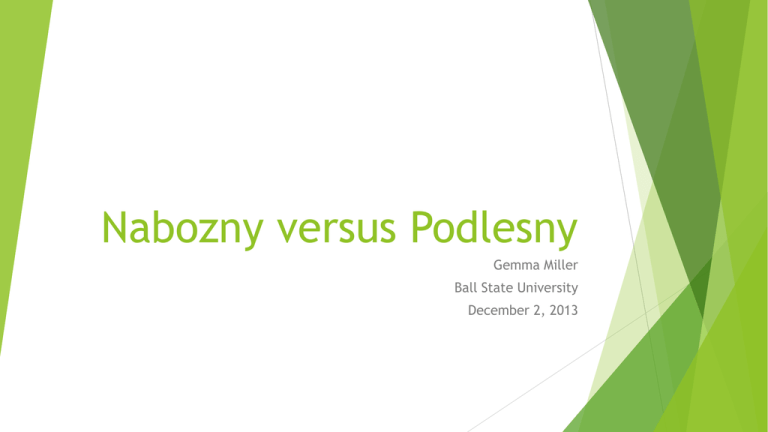
Nabozny versus Podlesny
Gemma Miller
Ball State University
December 2, 2013
Overview
Nabozny v. Podlesny Court Case
District Court Ruling
Effect on the community
How it affects school psychology?
Future implications
Chief Complaints
Plaintiff: Jamie Nabozny
Defendant:
Mary
Podlesny: Principal of Ashland Middle School
William Davis: Principal of Ashland High School
Thomas Blauert: Assistant Principal; of Ashland High
School
Steven Kelly: Administrator of the Ashland Public
School District
Problem: Nabozny reported that he was bullied
verbally and physically for being a homosexual
(Broz, 1998)
(Nabozny v. Podlesny, 1996)
Jamie was urinated on, pretend raped, kicked
him to the point where he needed stomach
surgery for internal bleeding (Nabozny v.
Podlesny, 1996)
School officials new of the ongoing abuse
‘boys will be boys’ and told Jamie that if he
was ‘going to be so openly gay,’ he should
‘expect’ such behavior from his fellow students
Jamie attempted suicide, dropped out of school,
and ran away
After leaving school in 11th grade, Nabozny filed a
civil rights suit (Broz, 1998)
(Nabozny v. Podlesny, 1996; “Nabozny vs. Podlesny”, 1996; “Nabozny v. Podlesny:
Facts of the case”, 2012)
Title IX: Education Amendment of
1972
Right to be free of gender-based violence and to
equal protection
Section 1681
Prohibition
against discrimination
“No
person in the US shall, on the basis of sex,
be excluded from participation in, be denied
the benefits of, or be subjected to
discrimination under any education program or
activity receiving Federal financial assistance”
(“Title IX, education amendments of 1972”, 2012)
Case History
October 1995- a school cannot be held liable for
the actions of students
December 1995- Opening brief with 7th Circuit
Court of Appeals.
July 1996- Constitutional obligation of public
schools to protect gay students from antigay
abuse.
November 1996- Jury finds school officials liable
for failing to stop antigay violence against
Nabozny under Title IX.
(“Nabozny vs. Podesny” 1996)
Legal Impact
First legal challenge to antigay violence in public
schools
Meant that school officials were not immune for a
failure to protect equal protection.
Public school could be liable financially if they
failed to protect students
Led to future advocacy for LGBTQ youth
(Reese, 1997; “Nabozny vs. Podesny” 1996; “Nabozny v. Podesny: Facts of the
case”, 2012)
LGBTQ Community
LGBTQ individuals are an minority subjected to
discrimination in todays society (Stader & Graca,
2007)
84.6% of LGBTQ students report being verbally
harassed while 40.1% report being physically
harassed. 18.8% of those students report being
harassed in school (Kosciw, Greytak, Diaz, &
Bartikiewicz, 2010)
These victims of antigay harassment has resulted
in 75% experiencing a decline in grades, 39%
having attendance problems, and 28% eventually
School Psychologist Role
Teachers, psychologists, and counselors play an
important role in shaping the lives of youth. They
can help by intervening in situations of
harassment, increasing acceptance and
appreciation of diversity, and helping to ensure a
safe learning environment in schools is available
to all students (McCabe & Rubinson, 2008).
Specialized training in the issues and difficulties
faced by LBGT youth
Change attitude and beliefs which leads to more
proactive behaviors
(Ajzen & Madden, 1986; McCabe &
Rubinson, 2008)
Reflection
A public school could be held accountable for not
stopping antigay abuse
Even though this court case was monumental,
there is still a lot of abuse happening for children
based on their sexual identity
Affecting children academically and
emotionally
School psychologists, teachers, counselors, etc.
need to be trained on the problems LGBT youth
often face
References
Ajzen, I., & Madden, T. J. (1986). Prediction of goal directed behavior:
Attitudes, intentions, and perceived behavioral control. Journal of
Experimental Social Psychology, 22, 453-474.
Broz, A. N. (1998). Nabozny v. Podlesny: A teenager’s struggle to end anti-gay
violence in public schools. Northwestern University Law Review, 92, 750–778
Decision from the U.S. Court of Appeals. (1996). Lambda Legal. Retrieved
from http://www.lambdalegal.org/in-court/legaldocs/nabozny_wi_19960731_decisioin-us-court-of-appeals
Kosciw, J. G., Greytak, E. A., Diaz, E. M., & Bartikiewicz, M. J. (2010). The
2009 national school climate survey: The experience of lesbian, gay, bisexual
and transgender youth in our nation’s schools. New York: GLSEN.
McCabe, P. C., & Rubinson, F. (2008). Committing to social justice: The
behavioral intention of school psychology and education trainees to advocate
for lesbian, gay, bisexual, and transgendered youth. School Psychology
Review, 37(4), 469-486.
Nabozny v. Podlesny. 92 F.3d 446, 457. (1996).
Nabozny v. Podlesny. (1996). Lambda Legal. Retrieved from
http://www.lambdalegal.org/in-court/cases/nabozny-v-podlesny
Nabozny v. Poldesny: Facts of the case. (2012). Education Law. Retrieved from
http://educational-law.org/466-nabozny-v-podlesny-facts-of-the-case.html
Reese, S. (1997). The law and gay-bashing in schools. Education Digest, 62(9),
46–49.
Stader, D. L., & Graca, T. J. (2007). Student-on-Student Sexual Orientation
Harassment: Legal Protections for Sexual Minority Youth. Clearing
House, 80(3), 117-122.
Title IX, education amendments of 1972. (1972). United States Department of
Labor. Retrieved from http://www.dol.gov/oasam/regs/statutes/titleix.htm
Weiner, C. (2005). Sex education: Recognizing anti-gay harassment as sex
discrimination under Title VII and Title IX. Columbia Human Right Review,
189.

